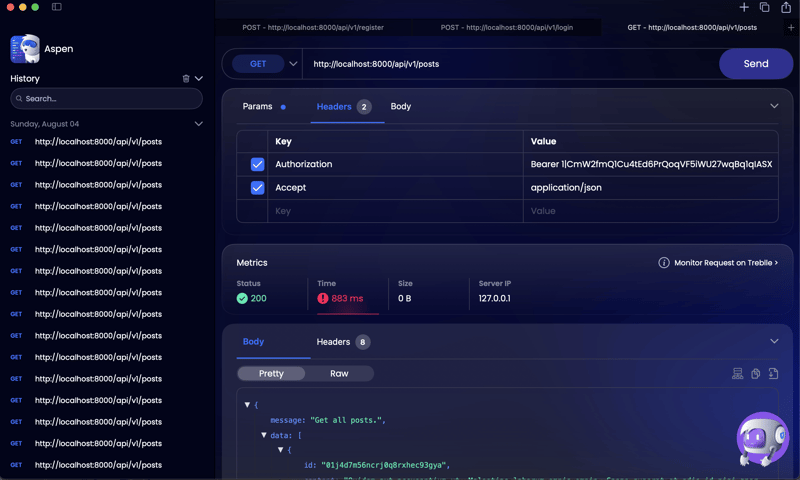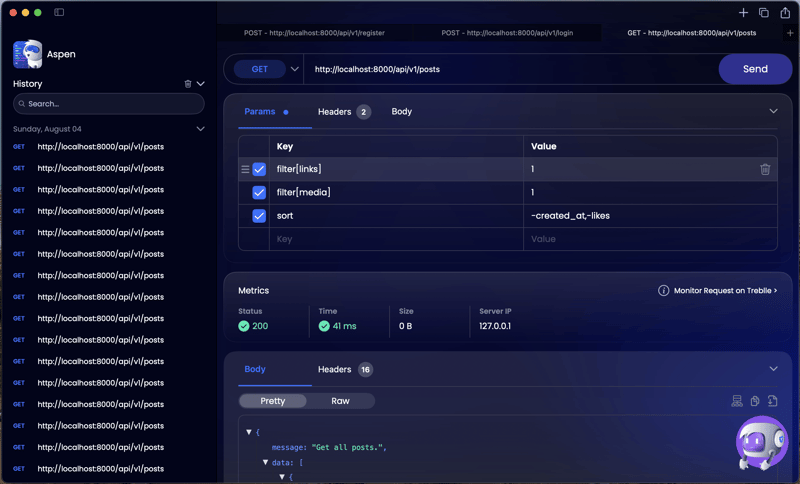如何为 Laravel API 构建缓存层
Let's say you are building an API to serve some data, you discover GET responses are quite slow. You have tried optimizing your queries, indexing your database tables by frequently queried columns and you are still not getting the response times you want. The next step to take is to write a Caching layer for your API. 'Caching layer' here is just a fancy term for a middleware that stores successful responses in a fast to retrieve store. e.g. Redis, Memcached etc. then any further requests to the API checks if the data is available in the store and serves the response.
Prerequisites
- Laravel
- Redis
Before we start
I am assuming if you have gotten here, you know how to create a laravel app. You should also have either a local or cloud Redis instance to connect to. If you have docker locally, you can copy my compose file here. Also, for a guide on how to connect to the Redis cache driver read here.
Creating our Dummy Data
To help us see our caching layer is working as expected. of course we need some data let's say we have a model named Post. so I will be creating some posts, I will also add some complex filtering that could be database intensive and then we can optimize by caching.
Now let's start writing our middleware:
We create our middleware skeleton by running
php artisan make:middleware CacheLayer
Then register it in your app/Http/Kernel.php under the api middleware group like so:
protected $middlewareGroups = [
'api' => [
CacheLayer::class,
],
];
But if you are running Laravel 11. register it in your bootstrap/app.php
->withMiddleware(function (Middleware $middleware) {
$middleware->api(append: [
\App\Http\Middleware\CacheLayer::class,
]);
})
Caching Terminologies
- Cache Hit: occurs when data requested is found in the cache.
- Cache Miss: happens when the requested data is not found in the cache.
- Cache Flush: clearing out the stored data in the cache so that it can be repopulated with fresh data.
- Cache tags: This is a feature unique to Redis. cache tags are a feature used to group related items in the cache, making it easier to manage and invalidate related data simultaneously.
- Time to Live (TTL): this refers to the amount of time a cached object stays valid before it expires. One common misunderstanding is thinking that every time an object is accessed from the cache (a cache hit), its expiry time gets reset. However, this isn't true. For instance, if the TTL is set to 5 minutes, the cached object will expire after 5 minutes, no matter how many times it's accessed within that period. After the 5 minutes are up, the next request for that object will result in a new entry being created in the cache.
Computing a Unique Cache Key
So cache drivers are a key-value store. so you have a key then the value is your json. So you need a unique cache key to identify resources, a unique cache key will also help in cache invalidation i.e. removing cache items when a new resource is created/updated. My approach for cache key generation is to turn the request url, query params, and body into an object. then serialize it to string. Add this to your cache middleware:
class CacheLayer
{
public function handle(Request $request, Closure $next): Response
{
}
private function getCacheKey(Request $request): string
{
$routeParameters = ! empty($request->route()->parameters) ? $request->route()->parameters : [auth()->user()->id];
$allParameters = array_merge($request->all(), $routeParameters);
$this->recursiveSort($allParameters);
return $request->url() . json_encode($allParameters);
}
private function recursiveSort(&$array): void
{
foreach ($array as &$value) {
if (is_array($value)) {
$this->recursiveSort($value);
}
}
ksort($array);
}
}
Let's go through the code line by line.
- First we check for the matched request parameters. we don't want to compute the same cache key for /users/1/posts and /users/2/posts.
- And if there are no matched parameters we pass in the user's id. This part is optional. If you have routes like /user that returns details for the currently authenticated user. it will be suitable to pass in the user id in the cache key. if not you can just make it an empty array([]).
- Then we get all the query parameters and merge it with the request parameters
- Then we sort the parameters, why this sorting step is very important is so we can return same data for let's say /posts?page=1&limit=20 and /posts?limit=20&page=1. so regardless of the order of the parameters we still return the same cache key.
Excluding routes
So depending on the nature of the application you are building. There will be some GET routes that you don't want to cache so for this we create a constant with the regex to match those routes. This will look like:
private const EXCLUDED_URLS = [
'~^api/v1/posts/[0-9a-zA-Z] /comments(\?.*)?$~i'
'
];
In this case, this regex will match all a post's comments.
Configuring TTL
For this, just add this entry to your config/cache.php
'ttl' => now()->addMinutes(5),
Writing our Middleware
Now we have all our preliminary steps set we can write our middleware code:
public function handle(Request $request, Closure $next): Response
{
if ('GET' !== $method) {
return $next($request);
}
foreach (self::EXCLUDED_URLS as $pattern) {
if (preg_match($pattern, $request->getRequestUri())) {
return $next($request);
}
}
$cacheKey = $this->getCacheKey($request);
$exception = null;
$response = cache()
->tags([$request->url()])
->remember(
key: $cacheKey,
ttl: config('cache.ttl'),
callback: function () use ($next, $request, &$exception) {
$res = $next($request);
if (property_exists($res, 'exception') && null !== $res->exception) {
$exception = $res;
return null;
}
return $res;
}
);
return $exception ?? $response;
}
- First we skip caching for non-GET requests and Excluded urls.
- Then we use the cache helper, tag that cache entry by the request url.
- we use the remember method to store that cache entry. then we call the other handlers down the stack by doing $next($request). we check for exceptions. and then either return the exception or response.
Cache Invalidation
When new resources are created/updated, we have to clear the cache, so users can see new data. and to do this we will tweak our middleware code a bit. so in the part where we check the request method we add this:
if ('GET' !== $method) {
$response = $next($request);
if ($response->isSuccessful()) {
$tag = $request->url();
if ('PATCH' === $method || 'DELETE' === $method) {
$tag = mb_substr($tag, 0, mb_strrpos($tag, '/'));
}
cache()->tags([$tag])->flush();
}
return $response;
}
So what this code is doing is flushing the cache for non-GET requests. Then for PATCH and Delete requests we are stripping the {id}. so for example if the request url is PATCH /users/1/posts/2 . We are stripping the last id leaving /users/1/posts. this way when we update a post, we clear the cache of all a users posts. so the user can see fresh data.
Now with this we are done with the CacheLayer implementation. Lets test it
Testing our Cache
Let's say we want to retrieve all a users posts, that has links, media and sort it by likes and recently created. the url for that kind of request according to the json:api spec will look like: /posts?filter[links]=1&filter[media]=1&sort=-created_at,-likes. on a posts table of 1.2 million records the response time is: ~800ms

and after adding our cache middleware we get a response time of 41ms

Great success!
Optimizations
Another optional step is to compress the json payload we store on redis. JSON is not the most memory-efficient format, so what we can do is use zlib compression to compress the json before storing and decompress before sending to the client.
the code for that will look like:
$response = cache()
->tags([$request->url()])
->remember(
key: $cacheKey,
ttl: config('cache.ttl'),
callback: function () use ($next, $request, &$exception) {
$res = $next($request);
if (property_exists($res, 'exception') && null !== $res->exception) {
$exception = $res;
return null;
}
return gzcompress($res->getContent());
}
);
return $exception ?? response(gzuncompress($response));
The full code for this looks like:
getMethod();
if ('GET' !== $method) {
$response = $next($request);
if ($response->isSuccessful()) {
$tag = $request->url();
if ('PATCH' === $method || 'DELETE' === $method) {
$tag = mb_substr($tag, 0, mb_strrpos($tag, '/'));
}
cache()->tags([$tag])->flush();
}
return $response;
}
foreach (self::EXCLUDED_URLS as $pattern) {
if (preg_match($pattern, $request->getRequestUri())) {
return $next($request);
}
}
$cacheKey = $this->getCacheKey($request);
$exception = null;
$response = cache()
->tags([$request->url()])
->remember(
key: $cacheKey,
ttl: config('cache.ttl'),
callback: function () use ($next, $request, &$exception) {
$res = $next($request);
if (property_exists($res, 'exception') && null !== $res->exception) {
$exception = $res;
return null;
}
return gzcompress($res->getContent());
}
);
return $exception ?? response(gzuncompress($response));
}
private function getCacheKey(Request $request): string
{
$routeParameters = ! empty($request->route()->parameters) ? $request->route()->parameters : [auth()->user()->id];
$allParameters = array_merge($request->all(), $routeParameters);
$this->recursiveSort($allParameters);
return $request->url() . json_encode($allParameters);
}
private function recursiveSort(&$array): void
{
foreach ($array as &$value) {
if (is_array($value)) {
$this->recursiveSort($value);
}
}
ksort($array);
}
}
Summary
This is all I have for you today on caching, Happy building and drop any questions, commments and improvements in the comments!
-
 如何在其容器中为DIV创建平滑的左右CSS动画?通用CSS动画,用于左右运动 ,我们将探索创建一个通用的CSS动画,以向左和右移动DIV,从而到达其容器的边缘。该动画可以应用于具有绝对定位的任何div,无论其未知长度如何。问题:使用左直接导致瞬时消失 更加流畅的解决方案:混合转换和左 [并实现平稳的,线性的运动,我们介绍了线性的转换。这...编程 发布于2025-07-05
如何在其容器中为DIV创建平滑的左右CSS动画?通用CSS动画,用于左右运动 ,我们将探索创建一个通用的CSS动画,以向左和右移动DIV,从而到达其容器的边缘。该动画可以应用于具有绝对定位的任何div,无论其未知长度如何。问题:使用左直接导致瞬时消失 更加流畅的解决方案:混合转换和左 [并实现平稳的,线性的运动,我们介绍了线性的转换。这...编程 发布于2025-07-05 -
 使用jQuery如何有效修改":after"伪元素的CSS属性?在jquery中了解伪元素的限制:访问“ selector 尝试修改“:”选择器的CSS属性时,您可能会遇到困难。 This is because pseudo-elements are not part of the DOM (Document Object Model) and are th...编程 发布于2025-07-05
使用jQuery如何有效修改":after"伪元素的CSS属性?在jquery中了解伪元素的限制:访问“ selector 尝试修改“:”选择器的CSS属性时,您可能会遇到困难。 This is because pseudo-elements are not part of the DOM (Document Object Model) and are th...编程 发布于2025-07-05 -
 在UTF8 MySQL表中正确将Latin1字符转换为UTF8的方法在UTF8表中将latin1字符转换为utf8 ,您遇到了一个问题,其中含义的字符(例如,“jáuòiñe”)在utf8 table tabled tablesset中被extect(例如,“致电。为了解决此问题,您正在尝试使用“ mb_convert_encoding”和“ iconv”转换受...编程 发布于2025-07-05
在UTF8 MySQL表中正确将Latin1字符转换为UTF8的方法在UTF8表中将latin1字符转换为utf8 ,您遇到了一个问题,其中含义的字符(例如,“jáuòiñe”)在utf8 table tabled tablesset中被extect(例如,“致电。为了解决此问题,您正在尝试使用“ mb_convert_encoding”和“ iconv”转换受...编程 发布于2025-07-05 -
 在GO中构造SQL查询时,如何安全地加入文本和值?在go中构造文本sql查询时,在go sql queries 中,在使用conting and contement和contement consem per时,尤其是在使用integer per当per当per时,per per per当per. [&&&&&&&&&&&&&&&&默元组方法在...编程 发布于2025-07-05
在GO中构造SQL查询时,如何安全地加入文本和值?在go中构造文本sql查询时,在go sql queries 中,在使用conting and contement和contement consem per时,尤其是在使用integer per当per当per时,per per per当per. [&&&&&&&&&&&&&&&&默元组方法在...编程 发布于2025-07-05 -
 Java中Lambda表达式为何需要“final”或“有效final”变量?Lambda Expressions Require "Final" or "Effectively Final" VariablesThe error message "Variable used in lambda expression shou...编程 发布于2025-07-05
Java中Lambda表达式为何需要“final”或“有效final”变量?Lambda Expressions Require "Final" or "Effectively Final" VariablesThe error message "Variable used in lambda expression shou...编程 发布于2025-07-05 -
 CSS可以根据任何属性值来定位HTML元素吗?靶向html元素,在CSS 中使用任何属性值,在CSS中,可以基于特定属性(如下所示)基于特定属性的基于特定属性的emants目标元素: 字体家庭:康斯拉斯(Consolas); } 但是,出现一个常见的问题:元素可以根据任何属性值而定位吗?本文探讨了此主题。的目标元素有任何任何属性值,属...编程 发布于2025-07-05
CSS可以根据任何属性值来定位HTML元素吗?靶向html元素,在CSS 中使用任何属性值,在CSS中,可以基于特定属性(如下所示)基于特定属性的基于特定属性的emants目标元素: 字体家庭:康斯拉斯(Consolas); } 但是,出现一个常见的问题:元素可以根据任何属性值而定位吗?本文探讨了此主题。的目标元素有任何任何属性值,属...编程 发布于2025-07-05 -
 为什么不使用CSS`content'属性显示图像?在Firefox extemers属性为某些图像很大,&& && && &&华倍华倍[华氏华倍华氏度]很少见,却是某些浏览属性很少,尤其是特定于Firefox的某些浏览器未能在使用内容属性引用时未能显示图像的情况。这可以在提供的CSS类中看到:。googlepic { 内容:url(&#...编程 发布于2025-07-05
为什么不使用CSS`content'属性显示图像?在Firefox extemers属性为某些图像很大,&& && && &&华倍华倍[华氏华倍华氏度]很少见,却是某些浏览属性很少,尤其是特定于Firefox的某些浏览器未能在使用内容属性引用时未能显示图像的情况。这可以在提供的CSS类中看到:。googlepic { 内容:url(&#...编程 发布于2025-07-05 -
 如何同步迭代并从PHP中的两个等级阵列打印值?同步的迭代和打印值来自相同大小的两个数组使用两个数组相等大小的selectbox时,一个包含country代码的数组,另一个包含乡村代码,另一个包含其相应名称的数组,可能会因不当提供了exply for for for the uncore for the forsion for for ytry...编程 发布于2025-07-05
如何同步迭代并从PHP中的两个等级阵列打印值?同步的迭代和打印值来自相同大小的两个数组使用两个数组相等大小的selectbox时,一个包含country代码的数组,另一个包含乡村代码,另一个包含其相应名称的数组,可能会因不当提供了exply for for for the uncore for the forsion for for ytry...编程 发布于2025-07-05 -
 左连接为何在右表WHERE子句过滤时像内连接?左JOIN CONUNDRUM:WITCHING小时在数据库Wizard的领域中变成内在的加入很有趣,当将c.foobar条件放置在上面的Where子句中时,据说左联接似乎会转换为内部连接。仅当满足A.Foo和C.Foobar标准时,才会返回结果。为什么要变形?关键在于其中的子句。当左联接的右侧值...编程 发布于2025-07-05
左连接为何在右表WHERE子句过滤时像内连接?左JOIN CONUNDRUM:WITCHING小时在数据库Wizard的领域中变成内在的加入很有趣,当将c.foobar条件放置在上面的Where子句中时,据说左联接似乎会转换为内部连接。仅当满足A.Foo和C.Foobar标准时,才会返回结果。为什么要变形?关键在于其中的子句。当左联接的右侧值...编程 发布于2025-07-05 -
 Python高效去除文本中HTML标签方法在Python中剥离HTML标签,以获取原始的文本表示Achieving Text-Only Extraction with Python's MLStripperTo streamline the stripping process, the Python standard librar...编程 发布于2025-07-05
Python高效去除文本中HTML标签方法在Python中剥离HTML标签,以获取原始的文本表示Achieving Text-Only Extraction with Python's MLStripperTo streamline the stripping process, the Python standard librar...编程 发布于2025-07-05 -
 如何将来自三个MySQL表的数据组合到新表中?mysql:从三个表和列的新表创建新表 答案:为了实现这一目标,您可以利用一个3-way Join。 选择p。*,d.content作为年龄 来自人为p的人 加入d.person_id = p.id上的d的详细信息 加入T.Id = d.detail_id的分类法 其中t.taxonomy =...编程 发布于2025-07-05
如何将来自三个MySQL表的数据组合到新表中?mysql:从三个表和列的新表创建新表 答案:为了实现这一目标,您可以利用一个3-way Join。 选择p。*,d.content作为年龄 来自人为p的人 加入d.person_id = p.id上的d的详细信息 加入T.Id = d.detail_id的分类法 其中t.taxonomy =...编程 发布于2025-07-05 -
 如何简化PHP中的JSON解析以获取多维阵列?php 试图在PHP中解析JSON数据的JSON可能具有挑战性,尤其是在处理多维数组时。要简化过程,建议将JSON作为数组而不是对象解析。执行此操作,将JSON_DECODE函数与第二个参数设置为true:[&&&&& && &&&&& json = JSON = JSON_DECODE($ j...编程 发布于2025-07-05
如何简化PHP中的JSON解析以获取多维阵列?php 试图在PHP中解析JSON数据的JSON可能具有挑战性,尤其是在处理多维数组时。要简化过程,建议将JSON作为数组而不是对象解析。执行此操作,将JSON_DECODE函数与第二个参数设置为true:[&&&&& && &&&&& json = JSON = JSON_DECODE($ j...编程 发布于2025-07-05 -
 找到最大计数时,如何解决mySQL中的“组函数\”错误的“无效使用”?如何在mySQL中使用mySql 检索最大计数,您可能会遇到一个问题,您可能会在尝试使用以下命令:理解错误正确找到由名称列分组的值的最大计数,请使用以下修改后的查询: 计数(*)为c 来自EMP1 按名称组 c desc订购 限制1 查询说明 select语句提取名称列和每个名称...编程 发布于2025-07-05
找到最大计数时,如何解决mySQL中的“组函数\”错误的“无效使用”?如何在mySQL中使用mySql 检索最大计数,您可能会遇到一个问题,您可能会在尝试使用以下命令:理解错误正确找到由名称列分组的值的最大计数,请使用以下修改后的查询: 计数(*)为c 来自EMP1 按名称组 c desc订购 限制1 查询说明 select语句提取名称列和每个名称...编程 发布于2025-07-05 -
 您可以使用CSS在Chrome和Firefox中染色控制台输出吗?在javascript console 中显示颜色是可以使用chrome的控制台显示彩色文本,例如红色的redors,for for for for错误消息?回答是的,可以使用CSS将颜色添加到Chrome和Firefox中的控制台显示的消息(版本31或更高版本)中。要实现这一目标,请使用以下模...编程 发布于2025-07-05
您可以使用CSS在Chrome和Firefox中染色控制台输出吗?在javascript console 中显示颜色是可以使用chrome的控制台显示彩色文本,例如红色的redors,for for for for错误消息?回答是的,可以使用CSS将颜色添加到Chrome和Firefox中的控制台显示的消息(版本31或更高版本)中。要实现这一目标,请使用以下模...编程 发布于2025-07-05 -
 如何在Java字符串中有效替换多个子字符串?在java 中有效地替换多个substring,需要在需要替换一个字符串中的多个substring的情况下,很容易求助于重复应用字符串的刺激力量。 However, this can be inefficient for large strings or when working with nu...编程 发布于2025-07-05
如何在Java字符串中有效替换多个子字符串?在java 中有效地替换多个substring,需要在需要替换一个字符串中的多个substring的情况下,很容易求助于重复应用字符串的刺激力量。 However, this can be inefficient for large strings or when working with nu...编程 发布于2025-07-05
学习中文
- 1 走路用中文怎么说?走路中文发音,走路中文学习
- 2 坐飞机用中文怎么说?坐飞机中文发音,坐飞机中文学习
- 3 坐火车用中文怎么说?坐火车中文发音,坐火车中文学习
- 4 坐车用中文怎么说?坐车中文发音,坐车中文学习
- 5 开车用中文怎么说?开车中文发音,开车中文学习
- 6 游泳用中文怎么说?游泳中文发音,游泳中文学习
- 7 骑自行车用中文怎么说?骑自行车中文发音,骑自行车中文学习
- 8 你好用中文怎么说?你好中文发音,你好中文学习
- 9 谢谢用中文怎么说?谢谢中文发音,谢谢中文学习
- 10 How to say goodbye in Chinese? 再见Chinese pronunciation, 再见Chinese learning

























